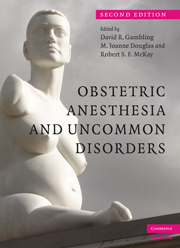Book contents
- Frontmatter
- Contents
- List of plates
- List of contributors
- Preface
- Section 1 Cardiovascular and respiratory disorders
- Section 2 Musculoskeletal disorders
- Section 3 Nervous system disorders
- Section 4 Metabolic disorders
- 13 Disorders of intermediary metabolism
- 14 Liver and renal disease
- 15 Malignant hyperthermia
- 16 Rare endocrine disorders
- Section 5 Other disorders
- Index
- Plate Section
- References
13 - Disorders of intermediary metabolism
from Section 4 - Metabolic disorders
Published online by Cambridge University Press: 19 October 2009
- Frontmatter
- Contents
- List of plates
- List of contributors
- Preface
- Section 1 Cardiovascular and respiratory disorders
- Section 2 Musculoskeletal disorders
- Section 3 Nervous system disorders
- Section 4 Metabolic disorders
- 13 Disorders of intermediary metabolism
- 14 Liver and renal disease
- 15 Malignant hyperthermia
- 16 Rare endocrine disorders
- Section 5 Other disorders
- Index
- Plate Section
- References
Summary
Introduction
There are a large number of inherited conditions that result from disorders of intermediary metabolism. These cause symptoms because of the build up of precursors, the absence of the final product, an excess of toxic intermediaries, or a combination of these mechanisms. Many are fatal in childhood, but some are compatible with adult life and pregnancy. These disorders may be encountered by an obstetric anesthesiologist (either because of their prevalence or, for some rare conditions, because modern management confers an improved chance of fertility). Some examples of these disorders can be found in Table 13.1. Malignant hyperthermia, plasma pseudocholinesterase deficiency, and inherited hematological, endocrine, connective tissue, or bone disorders are discussed elsewhere.
In all these rare disorders, a basic tenet of management is to refer to a specialist in the relevant field of medicine, to coordinate a multidisciplinary team approach and to make a thorough and early antenatal assessment, with documentation of a plan of management.
Glycogen storage diseases
Glucose metabolism plays a fundamental role in supplying energy for most cellular metabolic processes. Glycogen, the storage form of glucose, is composed of a branched polymer of glucose residues and can be found in muscle and liver. Defects in glycogen metabolism typically cause accumulation of glycogen in the tissues. Historically, the glycogen storage diseases have been classified numerically according to the specific enzyme defect. Since the main manifestations are either primarily related to liver or muscle, it may be more useful to categorize them according to the primary organ involved.
- Type
- Chapter
- Information
- Obstetric Anesthesia and Uncommon Disorders , pp. 239 - 248Publisher: Cambridge University PressPrint publication year: 2008



